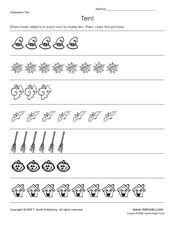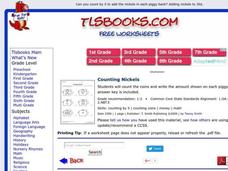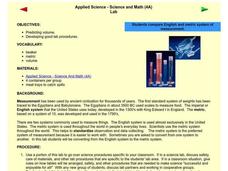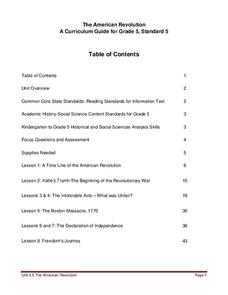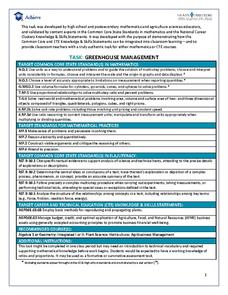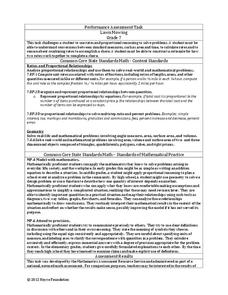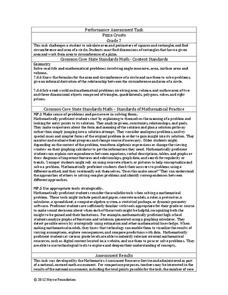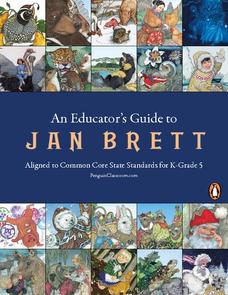Read Works
A Constitution for Kids
What better day to celebrate the US Constitution than on Constitution Day! After reading a short passage about the different understandings of habeas corpus and ex post facto, sixth graders respond to 10 multiple choice and short answer...
T. Smith Publishing
Ten! A Halloween Worksheet
Boo! Little goblins count the Halloween-themed objects arranged in rows. They draw enough to bring each row to a total of 10. Use this when addressing the Common Core initiative in October with your kindergarten class.
T. Smith Publishing
Finding Percentages 6A
A list of 20 two to three-digit numbers asks math whizzes to determine specified percentages for each. The publisher has linked the assignment to CCSS.Math.Content.6RP.3, and it is targeted at the discreet skill of finding a percent of a...
Curated OER
Counting Nickels
This little piggy went to market! Piggy banks are displayed on this page with varying numbers of nickels on each. Coin counters count by 5s to determine how much money each piggy holds. This is a clever instructional activity for...
T. Smith Publishing
Counting Turtles
What child is not drawn to turtles? Seven different groups of turtles are depicted on this handout for them to count. They write the number in a large box on the right side of the page. This simple activity helps to meet counting goals...
Curated OER
Count, Trace, and Print Numbers 1 to 20
The first of these four pages deals with numerals 1 - 5, and subsequent pages cover the following sets of five numerals. For each, one or two dominoes display the number of spots, dotted lines with arrows instruct how to write the...
Curated OER
Applied Science - Science and Math Lab
Although it was written to use in a science class, this measurement lesson is adaptable to Common Core standards in math for measurement and data. Youngsters are introduced to two types of measurement systems. They use both the English...
Curated OER
A Yen for Maximum Residue Limits in Food
Future public health officials or agriculturists read an article and answer questions concerning the Japanese regulations for pesticide exposure. They compare the maximum residue limit for two, 4-D of Japan with other countries. This is...
Curated OER
Classroom Supplies
Challenge young mathematicians to buy classroom supplies by staying within the means of a $1,000 budget. The mathematical activity provides learners with the opportunity to decide what items from the supply list would benefit a class of...
Intel
Forensics: Get a Clue
Although the methods are all scientific, forensic science was started by police officers rather than scientists, who relied on observation and common sense. Young detectives use many tools to solve crimes around the school in a...
California State University
The American Revolution
Invite your class on a ride through the American Revolution. Young historians travel through time as they explore the events that led to the foundation of the United States of America. Over the course of eight lessons, this unit provides...
Curated OER
The Bell Curve
Students explore the concept of the bell curve. In this bell curve instructional activity, students discuss the controversy associated with the bell curve. Students use an applet to explore a normal distribution. Students discuss...
Curated OER
Map Study
In this geography worksheet, students study the United States. Students respond to 6 multiple choice questions about the map.
Noyce Foundation
Parallelogram
Parallelograms are pairs of triangles all the way around. Pupils measure to determine the area and perimeter of a parallelogram. They then find the area of the tirangles formed by drawing a diagonal of the parallelogram and compare their...
Inside Mathematics
Quadratic (2006)
Most problems can be solved using more than one method. A worksheet includes just nine questions but many more ways to solve each. Scholars must graph, solve, and justify quadratic problems.
Inside Mathematics
Winning Spinners
Winning a spin game is random chance, right? Pupils create a table to determine the sample space of spinning two spinners. Individuals determine the probability of winning a game and then modify the spinners to increase the probability...
Walt Disney Company
Elizabeth Started All the Trouble
Elizabeth Cady Stanton was a famous suffragette that paved the way for equal rights for women. Readers respond to before, during, and after reading questions based on her story. The resource is a great addition to a lesson plan during...
Achieve
Greenhouse Management
Who knew running a greenhouse required so much math? Amaze future mathematicians and farmers with the amount of unit conversions, ratio and proportional reasoning, and geometric applications involved by having them complete the...
Noyce Foundation
Lawn Mowing
This is how long we mow the lawn together. The assessment requires the class to work with combining ratios and proportional reasoning. Pupils determine the unit rate of mowers and calculate the time required to mow a lawn if they work...
Noyce Foundation
Truffles
Knowing how to scale a recipe is an important skill. Young mathematicians determine the amount of ingredients they need to make a certain number of truffles when given a recipe. They determine a relationship between ingredients given a...
Inside Mathematics
Marble Game
Pupils determine the theoretical probability of winning a game of marbles. Individuals compare the theoretical probability to experimental probability for the same game. They continue on to compare two different probability games.
Noyce Foundation
Time to Get Clean
It's assessment time! Determine your young mathematicians' understanding of elapsed time with this brief, five-question quiz.
Noyce Foundation
Pizza Crusts
Enough stuffed crust to go around. Pupils calculate the area and perimeter of a variety of pizza shapes, including rectangular and circular. Individuals design rectangular pizzas with a given area to maximize the amount of crust and do...
Penguin Books
An Educator's Guide to Jan Brett
Prepare to teach Jan Brett stories by taking a look at this teacher resource, which includes text-based questions, writing assignments, discussion ideas, and vocabulary practice for 18 different stories.



